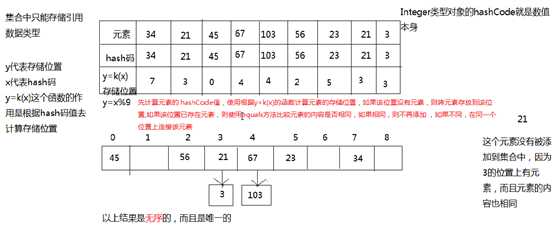标签:运行 注意 就是 nbsp 存储位置 集合 img 实现类 private
HashSet是Set接口的实现类,其底层数据结构为哈希表。
HashSet是线程不安全的(不保证同步)。
HashSet优点:添加、删除、查询效率高。
缺点:无序
首先,拿到元素,计算元素的HashCode值,使用根据y=K(x)的哈希函数计算出元素的存储位置,如果该位置没有元素,则将元素存放到该位置。如果该位置上已经存在元素,则使用equals方法比较元素的内容是否相同,如果相同,则不再添加进去,摒弃掉。如果不同,则在同一个位置拉链一个空间放置该元素。
注意1:y代表存储位置,x代表hashCode值,即哈希码,y=K(x)的作用是根据哈希码去计算存储位置。
注意2:Integer类型对象的哈希码就是对象的数值本身。
注意3:HashSet是无序的,元素是唯一的。

如果要向HashSet中存储元素时,元素对象中一定要实现hashCode方法和equals方法,不然会运行报错。因为根据哈希表原理,存储时要使用hashCode方法和equals方法进行判断存储的位置。
1 package cn.sxt03.hashset; 2 3 public class Student { 4 private String id; 5 private String name; 6 private int age; 7 8 // … 9 10 11 @Override 12 public int hashCode() { 13 final int prime = 31; 14 int result = 1; 15 result = prime * result + age; 16 result = prime * result + ((id == null) ? 0 : id.hashCode()); 17 result = prime * result + ((name == null) ? 0 : name.hashCode()); 18 return result; 19 } 20 21 @Override 22 public boolean equals(Object obj) { 23 if (this == obj) 24 return true; 25 if (obj == null) 26 return false; 27 if (getClass() != obj.getClass()) 28 return false; 29 Student other = (Student) obj; 30 if (age != other.age) 31 return false; 32 if (id == null) { 33 if (other.id != null) 34 return false; 35 } else if (!id.equals(other.id)) 36 return false; 37 if (name == null) { 38 if (other.name != null) 39 return false; 40 } else if (!name.equals(other.name)) 41 return false; 42 return true; 43 } 44 45 @Override 46 public String toString() { 47 return "Student [id=" + id + ", name=" + name + ", age=" + age + "]"; 48 } 49 50 }
标签:运行 注意 就是 nbsp 存储位置 集合 img 实现类 private
原文地址:https://www.cnblogs.com/luojack/p/10816518.html